Kitesurfing in Miami Beach: A Complete Guide
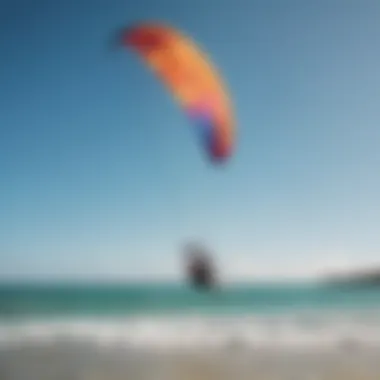
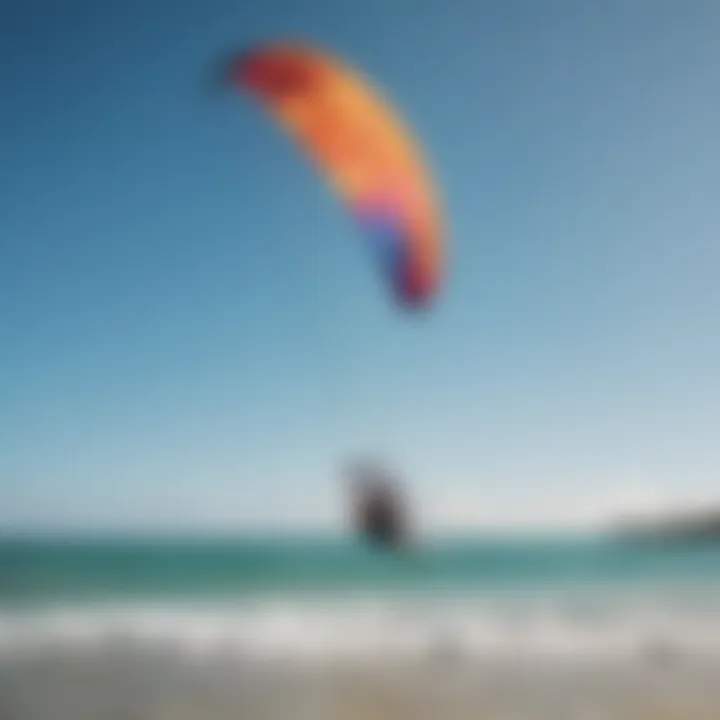
Intro
Kitesurfing in Miami Beach is not just a sport—it's a way of life. With its sun-drenched shores and breathtaking vistas, this vibrant coastal city attracts both seasoned veterans and curious newcomers eager to test their mettle against the Atlantic waves. The strong and consistent winds, coupled with warm waters, create an ideal playground for the kitesurfing community. Here, enthusiasts can enjoy everything from tranquil sessions during the morning hours to adrenaline-fueled rides as the wind picks up later in the day.
In this guide, we'll take you through the various aspects of kitesurfing in Miami Beach, including what equipment you'll need, where to find the best spots, techniques for every skill level, and crucial safety guidelines. Whether you're just starting on your kitesurfing journey or you're a seasoned pro looking to refine your skills and explore new adventures, you’ll find comprehensive insights tailored specifically for you. So grab your gear, and let’s dive into the world of kitesurfing in this incredible seaside destination!
Prologue to Kitesurfing
Kitesurfing is more than just a sport; it's a thrilling dance between sea, sky, and spirit. As the wind fills the kite, riders can feel a rush that comes with harnessing nature’s elements. This sport has gained momentum globally, and Miami Beach, with its vibrant coastline, offers one of the most enticing backdrops for both novices and seasoned kitesurfers.
Kitesurfing can be pivotal for anyone looking to spice up their water sports game. The blend of wind and water presents an array of challenges and joys. Riders get the chance to engage in a unique blend of surfing and sailing, making it an incredible workout and an adrenaline-packed adventure. In addition, the tight-knit community of kitesurfers you encounter fosters a feeling of camaraderie and shared experience.
The Evolution of Kitesurfing
Kitesurfing has come a long way since its inception. Initially, kites were used as a form of transportation and fun, but the blending of surfing and kiting truly gained traction in the late 20th century. The first major kitesurfing devices appeared in the 1980s, but it wasn't until marketing and technology matured that kitesurfing found its footing as a popular water sport.
Today’s kites are designed with advanced materials, giving riders increased control and performance on the water. Innovations in board design have also played a crucial role in the evolution of kitesurfing, allowing riders to showcase incredible tricks and maneuvers. The accessibility and variety in equipment have lured many into the sport, making it more enjoyable for all levels of skill. Ultimately, kitesurfing has blossomed from a niche activity to a mainstream sport that captures the essence of adventure.
Why Choose Miami Beach?
Opting to kitesurf in Miami Beach is like picking the cherry on top of a perfect sundae. With a warm climate, consistent winds, and beautiful scenery, it's a paradise for kitesurfing enthusiasts.
Firstly, the weather is spot-on for this activity. Miami Beach holds a unique tropical climate, boasting sufficient wind throughout much of the year. You don’t have to wait too long for the right conditions to hit the water.
Secondly, the water quality is another key aspect that sways many towards this destination. With clear blue waters and sandy beaches, the experience of gliding across the surface is second to none. In addition, the beaches are equipped with ample space for entry and exit, making it less stressful for beginners learning the ropes.
Lastly, the community vibe in Miami is simply electrifying. The kitesurfing scene pulsates with energy, where skilled riders are often eager to share their knowledge. The atmosphere injects life into the sport, giving you the support you need. Besides, with its distinctive fusion of cultures, Miami Beach presents a colorful backdrop that you won't easily forget.
Local Kitesurfing Conditions
When it comes to kitesurfing, the local conditions can make or break your experience. Understanding these factors not only enhances your enjoyment but also ensures your safety on the water. In Miami Beach, the unique combination of wind and tide creates an ideal environment for kitesurfing, attracting enthusiasts from around the world.
Wind Patterns in Miami Beach
Wind is the heart and soul of kitesurfing. In Miami Beach, the trade winds offer consistent, steady winds, especially during the spring and summer months. Typically blowing from the east, these winds can reach speeds of around 12 to 25 knots, which is considered optimal for kitesurfing. This steady breeze allows kite surfers to ride the waves with ease, making it a perfect playground for both beginners and seasoned pros.
Moreover, understanding the local wind patterns is crucial for effective navigation. For example, during the cooler months, the winds tend to shift; knowing this can help kitesurfers choose the right times to hit the water.
"The right winds can transform a mediocre session into a spectacular one."
Tide Influences on Kitesurfing
Tide plays a significant role that often gets overlooked by beginners. In Miami Beach, the tides can greatly affect water depth and current, which in turn impacts your kitesurfing experience. As the tide changes, different areas become more suitable for kitesurfing.
Typically, riding is more favorable during high tide when currents are less aggressive. Conversely, low tide exposes sandbars and might create challenging conditions, especially for those still learning the ropes. Be mindful of these variations to avoid undesirable scenarios, like getting stuck on shallow grounds.
Best Seasons for Kitesurfing
Timing can make all the difference in the quality of your kitesurfing sessions. In Miami Beach, late spring to early summer (from April to June) is often regarded as the peak season for kitesurfing. During this period, the winds are especially consistent, and the water is warm, making it ideal for a long day out on the water.
However, fall (particularly September and October) also offers some gems, as the tail end of hurricane season can produce powerful winds and waves, but caution is paramount during this time. Being aware of these patterns can help you seize the right moments for optimal kitesurfing adventures.
In summary, understanding local kitesurfing conditions in Miami Beach—such as wind patterns, tide influences, and seasonal variations—provides valuable insights. This knowledge not only enhances your kitesurfing skills but contributes to an overall safer and more enjoyable experience.
Essential Kitesurfing Equipment
Kitesurfing thrives on the appropriate gear. You could have the best skills in the world, but the wrong equipment can derail your experience entirely. Understanding the essential kitesurfing equipment is not just about making a purchase. It’s about making informed choices that enhance your safety, performance, and enjoyment on the water. Each piece is vital in ensuring you’re not just floating along but truly riding the waves.
Choosing the Right Kite


Picking a kite can be likened to choosing a dance partner. You want something that complements your style and skill level. Kites come in various sizes and types, each playing a unique role depending on wind conditions and your personal level.
- Types of Kites: The two main types are ram-air and leading-edge inflated (LEI). Each type serves different conditions. If you’re planning to tackle the waves, an LEI might be more suitable. Yet, for those calm, flat water days, a ram-air should work fine.
- Kite Size: Size matters as well. A larger kite generates more power in light winds, but it's a handful in stronger conditions. Start small; as you hone your skills, you can graduate to bigger setups.
Each kite brings its unique flavor to your ride. Mixing and matching until you find what works for you is part of the adventure. Make a smart choice; it's your ride, after all.
The Importance of Board Selection
Board choice in kitesurfing is like finding the perfect shoes for an evening out: a matter of both style and substance. The board you choose can significantly impact your control and maneuverability on the water.
- Types of Boards: There are directional boards and twintips. Directional boards are fantastic for wave riding, while twintip boards are all-around performers. Think about what type of riding you do more; this influences your decision greatly.
- Size and Shape: A shorter board offers increased speed and tricks, while a wider board provides more surface area, which can be beneficial in light winds and for new riders.
It's key to choose a board that's in tune with your skills and the conditions you face most often. Keep in mind that comfort can enhance your ride infinitely.
Safety Gear and Accessories
Kitesurfing may look like a thrilling venture, but safety should never take a backseat. This sport has its risks, and using safety gear is akin to wearing a seatbelt in a car. Essential safety gear includes:
- Harness: This is perhaps one of the most critical pieces. A good harness can help distribute the kite's pull across your body rather than one concentrated spot, preventing fatigue.
- Helmet: Protect your noggin! Head injuries can be severe; wearing a helmet can save you from untold issues.
- Impact Vest: These vests provide flotation and protection, especially for those who like aerial tricks and wave riding.
Even beyond these essentials, think of accessories like spare lines, quick-dry towels, and a first-aid kit.
Safety isn’t just the absence of danger; it’s having equipment that enhances your confidence on the water.
In kitesurfing, the right gear can make or break your experience. Embrace it, respect it, and ride wisely.
Learning to Kitesurf
Kitesurfing is not just a thrill-seeking sport; it’s an art that blends strength, balance, and technique. For those wanting to get their feet wet in this exhilarating endeavor, understanding the fundamentals of learning to kitesurf is essential. Not only does this knowledge lay the groundwork for future progression, but it also equips you with confidence and safety awareness. Learning to kitesurf opens up a world of adventure and can be an enriching experience, both physically and socially.
Finding the Right Instructor
Choosing a kitesurfing instructor is undeniably one of the most critical steps in your kitesurfing journey. A competent instructor not only teaches you the basic skills but also instills the right mindset needed for the sport.
Here are several key aspects to consider when on the hunt for the right teacher:
- Experience and Qualifications: Look for instructors with certified training from recognized organizations, such as the International Kiteboarding Organization (IKO) or the Professional Airsports Association (PAA).
- Teaching Style: Communication is vital. Take note if the instructor explains concepts clear and has patience when teaching. The best instructors adapt their approach according to each student’s learning pace.
- Safety Focus: An important part of any instruction is safety. An experienced instructor should emphasize safety protocols, including proper equipment checks and emergency strategies.
- Reputation: Seek out reviews or testimonials from former students. First-hand experiences will give you insight into the instructor's effectiveness.
Finding the right instructor can make or break your experience as a beginner. Take your time and don’t hesitate to seek recommendations from local kitesurfing schools or enthusiasts.
Key Techniques for Beginners
Once you’ve secured your instructor, you can dive into the nitty-gritty of learning to kitesurf. Below are some essential techniques aimed at those taking their first swings at the sport:
- Control the Kite: The absolute fundamental is getting comfortable controlling your kite. Practice flying the kite on the ground before trying it on water. This can enhance your response to changing wind conditions.
- Launching and Landing: Learning the proper techniques for launching and landing your kite is crucial. It’s worth repeating until it feels second nature. Practice with your instructor, so they can guide you through the steps.
- Body Positioning: Maintaining a good body stance will make a world of difference. Keep your knees slightly bent and your hips relaxed to adapt easily to the movements.
- Tacking and Gybe: These maneuvering techniques are essential for turning and changing direction while riding.
While these techniques can sound daunting at first, incremental practice and their application during lessons will eventually improve your skills. Remember, the journey of kitesurfing is as thrilling as the destination.
Understanding Safety Protocols
Safety should never be an afterthought when kitesurfing. As exhilarating as it is to ride the waves, being prepared is crucial. Here's a run-through of some core safety protocols that every beginner needs to be aware of:
- Pre-flight Checks: Always conduct a thorough inspection of your gear before hitting the water. Make sure that everything is operational and secure.
- Know Your Environment: Familiarize yourself with the area where you’re kitesurfing. Understanding the local conditions—like wind patterns and potential hazards—ensures that you are prepared.
- Wear the Right Gear: It’s essential to wear a personal flotation device and consider a helmet for additional safety.
- Emergency Signals: Agree on hand signals with your partner or instructor. This can be vital for communication, especially on windy days.
- Respect the Conditions: If the wind seems too strong or the water looks choppy, it’s better to sit this one out. Adapting your kitesurfing based on the conditions is a sign of maturity in the sport.
Kitesurfing can provide some of the best adrenaline rushes out there. But ensuring your safety safeguard will lead to a more enjoyable experience overall.
Advanced Kitesurfing Techniques
Kitesurfing in Miami Beach isn't just about riding the waves or flying high; it's an art that can be perfected over time. Advanced kitesurfing techniques take your skills to another level, introducing excitement and challenges. Learning these techniques not only helps enhance your performance but also adds a whole new layer to the thrill of the sport. When you're zooming through the winds and catching air, that's when the real fun begins, and mastering these techniques can make that experience even better.
Jumping and Tricks
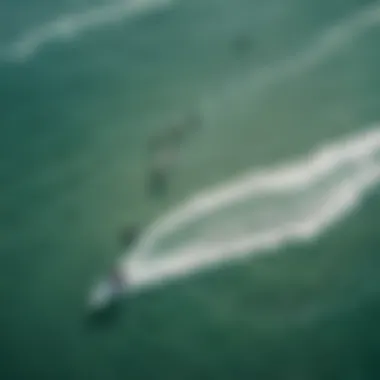

Jumping is often considered the crown jewel of kitesurfing. It’s the moment when your heart races as you leave the water behind, defying gravity for that brief but exhilarating second. However, jumping isn't just a random leap into the air; it requires technique and control.
- Timing and Technique: Performing jumps successfully relies on your timing with the kite. As you approach the wave, you must pull on the back of your kite to generate lift just as your board hits the top of the wave. This precision is what separates advanced kitesurfers from beginners.
- Proper Takeoff: There's an important distinction to be made between a good takeoff and a great one. As you prepare to jump, flex your knees slightly as the kite reaches the 11 o'clock position. This will aid in pushing off the water, giving you that much-needed power to get airborne.
- Trick Progression: Once you’re comfortable with basic jumps, you can start incorporating tricks. From board grabs to rotations, starting with simpler maneuvers and gradually progressing to more complex ones, such as the kite loop, can help you build confidence while improving your skills.
Don't forget to watch videos or attend workshops to visualize these techniques. Also, try to connect with more experienced kitesurfers who can provide hands-on guidance.
"Jumping is a dance with the winds; the more you practice the moves, the more graceful you’ll become on the water."
Wave Riding Strategies
Riding waves is a unique thrill that tests your skills, balance, and understanding of dynamics. Mastering wave riding strategies is essential for elevating both your performance and enjoyment while kitesurfing off the coast of Miami Beach.
- Positioning: Knowing where to position yourself relative to the waves is crucial. Ideally, you'll want to sit slightly further out, allowing you to pick up the ideal wave and ride it to shore. Watch the breaking waves to spot the best opportunities for riding.
- Board Placement: Place your board at an angle that allows you to take advantage of the wave's power. A little tilt on the board can help maintain speed while giving you the chance to carve or ride in whichever direction the wave is moving.
- Edge Control: Controlling your board’s edge is vital for maintaining balance when navigating waves. Lean on your heels or toes depending on the direction you're riding, and remember to keep your weight centered over your board as you maneuver.
Advanced riders often have unique styles and techniques, so don't hesitate to experiment or even adopt some habits from others you know or see. Local shops or kitesurfing schools often offer clinics focusing on these advanced techniques—take advantage of them to sharpen your skills.
By incorporating jumping techniques and refining your strategies for wave riding, you will not only improve your overall kitesurfing experience but also join the ranks of those kitesurfers who truly embrace the freedom and thrill of this vibrant sport.
Local Kitesurfing Spots
Understanding the local kitesurfing spots in Miami Beach is pivotal for anyone looking to dive into this thrilling water sport. Choosing the right location can significantly impact your experience, whether you're a novice learning the ropes or an experienced rider hunting for waves and winds. Each spot offers its unique characteristics, including wind conditions, waves, and the local community, catering to different skill levels and preferences.
The allure of Miami Beach lies in its diverse range of kitesurfing venues, each providing something distinct. Not only does this increase your opportunities to hit the water, but it also allows you to connect with fellow enthusiasts. Local spots can be a hive of activity, where everyone shares tips, stories, and even gear. Hence, knowing where to go can enhance your enjoyment and growth in the sport.
Top Locations in Miami Beach
When talking about top locations for kitesurfing, several places come to mind, largely thanks to their consistent winds and welcoming conditions. Here are a few noteworthy spots:
- South Beach: This iconic beach isn’t just a tourist destination. It offers great wind conditions for both beginners and seasoned kitesurfers alike. Expect friendly crowds and often lively conditions, making it perfect for fun sessions.
- Hobie Beach: Located in Key Biscayne, Hobie Beach is known for its spacious area and less crowded waters. With steady winds and a more relaxed atmosphere, it's ideal for practicing new tricks or simply enjoying a leisurely ride.
- Crandon Park: Nestled along the coast, this spot stands out due to its breathtaking scenery and plenty of space. It’s more popular among intermediate and advanced riders who enjoy exploring the waves and testing their limits.
Each of these locations varies in terms of water conditions and wind patterns. Exploring these options will help you figure out where you feel most comfortable and challenged.
Hidden Gems for Kitesurfing
While the mainstream beaches often get the limelight, some hidden gems in the Miami Beach area should not be overlooked. These spots might not be on every kitesurfer's radar, but they offer unique advantages:
- Virginia Key: A lesser-known spot, Virginia Key offers stunning views and grateful conditions. The surroundings are less commercialized, giving you a more natural kitesurfing experience.
- Matheson Hammock Park: Ideal for beginners who might feel overwhelmed at busier locations, this spot provides calm waters and consistent winds. The lush backdrop also helps create a serene atmosphere.
- Bill Baggs Cape Florida State Park: Located at the south end of Key Biscayne, this is another remarkable area that combines gorgeous landscapes with good wind. It provides a unique environment away from the hustle and bustle.
Exploring these hidden spots can open up a whole new world of kitesurfing experiences. Each place offers tranquil settings, making it easier to focus on honing your skills or simply enjoying the sport away from larger crowds.
"Diversity in locations is key; the right spot takes your kitesurfing from good to unforgettable."
Having a variety of local kitesurfing spots at your disposal ensures that every session brings something fresh. Depending on the wind, the wave heights, or even the crowd size, you might choose a different location each time. This exploration can extend beyond just riding; those backdrops can set the stage for building bonds within the community, enhancing the kitesurfing culture in Miami Beach.
Community and Culture
Kitesurfing in Miami Beach is more than just a sport; it embodies a rich culture and a strong community. The enthusiasts in this sunny locale come from various backgrounds and skill levels, united by a common love for the wind, the ocean, and the thrill of gliding atop waves. The culture surrounding kitesurfing here fosters camaraderie, sharing of knowledge, and mutual respect among riders.
The connections formed within this community can greatly enhance an individual’s kitesurfing experience. Whether you're a newbie or a seasoned rider, tapping into this network provides opportunities for learning, collaboration, and making lifelong friends who share the same passions.
Networking with Other Kitesurfers
Meeting fellow kitesurfers is crucial, especially for newcomers. Miami Beach hosts numerous meetups, workshops, and informal gatherings where riders exchange tips and stories. These informal connections often lead to valuable insights about local spots, including wind conditions that might not be found in official guides.
One popular gathering spot is South Beach, where riders congregate to share gear, discuss techniques, and even swap stories about their latest adventures. It’s not just about riding together; it’s about building relationships that can support one’s journey in the sport. Additionally, social media groups and platforms like Reddit also bolster this sense of community, allowing riders to coordinate sessions and discuss issues.
"Connecting with others has not only improved my skills, but it has also made the sport more enjoyable. Sharing a wave with friends is a feeling like no other."
Events and Competitions
Miami Beach is a hotspot for kitesurfing events, from local competitions to international tournaments. Participating in these gatherings does wonders for skill development and motivation. Events like the Miami Kiteboarding Festival offer riders the chance to compete against some of the best in the business. For spectators, these competitions create a vibrant atmosphere filled with excitement and energy, showcasing impressive feats and inspiring newcomers.
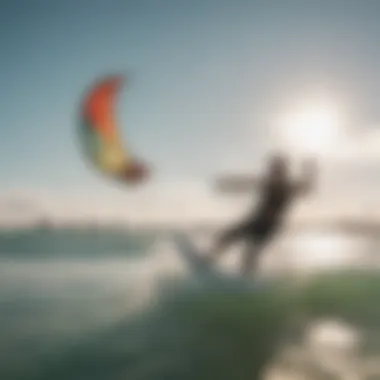
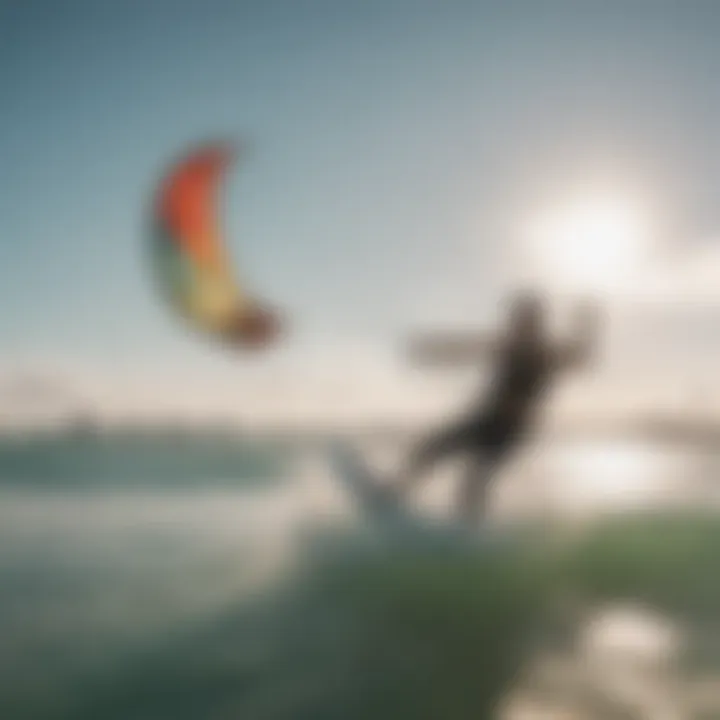
Furthermore, local schools often host friendly competitions that cater to varying skill levels. Taking part in these events allows riders to measure their progress and become part of the larger kitesurfing family. In addition, attendees often discuss techniques, providing invaluable advice that can elevate one’s skills.
The Kitesurfing Lifestyle
The kitesurfing lifestyle in Miami Beach is as colorful as its sunsets. It is marked by a passionate dedication to adventure and a commitment to environmental consciousness. Many riders incorporate fitness routines that complement their kitesurfing practice, whether it's yoga for flexibility or strength training to enhance endurance. The laid-back beach culture reflects a balance between thrill-seeking and eco-awareness.
Moreover, local kitesurfers are often advocates for preserving the gorgeous coastal lines they enjoy every day. Many engage in beach clean-ups or participate in educational outreach programs about marine conservation. This sense of responsibility enriches their identity as kitesurfers, turning participants into stewards of the coast.
In summary, the kitesurfing community and its associated culture are integral to the experience in Miami Beach. The connections formed, the events held, and the lifestyle adopted all contribute to a close-knit circle that not only enhances the passion for kitesurfing but also makes Miami Beach one of the most sought-after destinations for kitesurfers around the globe.
Kitesurfing Safety Guidelines
Safety is the backbone of kitesurfing, particularly in a bustling locale like Miami Beach. As much as this sport offers exhilarating thrills, it also comes with significant risks if safety measures are not observed. Understanding and implementing safety guidelines can mean the difference between a thrilling experience and a potentially dangerous situation. Therefore, it’s crucial for both novice and seasoned kitesurfers to familiarize themselves with these protocols, which not only protect the individual but also enhance the overall experience for everyone on the water.
Essential Safety Practices
Following a few core safety practices can greatly reduce the likelihood of accidents while kitesurfing. Here are some key points to consider:
- Pre-Flight Checks: Always inspect your gear before heading out. Ensure your kite's lines are untangled, the bladder is inflated, and all components are in working order. A quick check can save you from a rough ride.
- Know Your Limits: Don't stretch yourself too thin. If conditions exceed your skill level, it's best to wait for calmer winds or seek out less challenging waters. It’s about playing it smart and staying within your comfort zone.
- Wear Safety Gear: At the very least, a helmet and impact vest should be worn. These can protect vital areas of your body from injuries caused by falls or unexpected kite encounters. It might feel like overkill, but safety is never a bad idea.
- Understand Wind Directions: Knowledge of wind conditions is essential. Kiting in an offshore wind can lead to dangerous situations where self-rescue becomes tricky. Always kite with the wind coming from a safe direction.
- Communicate Clearly: When kitesurfing with others, make sure to communicate about your intentions. Giving a simple wave or making eye contact can work wonders in avoiding collisions at sea.
"Safety doesn't happen by accident. It requires proper planning and constant mindfulness of the environment."
Emergency Responses
Even with thorough preparations, mishaps can occur. Knowing how to respond in an emergency is critical. Here are some responses that could prove life-saving:
- Self-Rescue Techniques: If you find yourself in a tough spot, the ability to self-rescue is invaluable. Familiarize yourself with how to detach your kite quickly and use the board to paddle back to safety. Practicing this when you’re not in crisis can prepare you for when the moment strikes.
- Call for Help: If you’re in a dire situation, don’t hesitate to signal for assistance. Observers on the shore or fellow kitesurfers can be your best lifeline. Make sure you know how to get their attention without worsening your position.
- Stay Calm: In the face of an emergency, keeping a cool head is essential. Panicking can lead to poor decisions that might escalate the situation. Remember your training and react appropriately, taking deep breaths to steady your nerves.
- Know Local Emergency Contacts: Have a list of local emergency contacts readily available. This includes the nearest medical facility and local rescue services. In some cases, knowing the right number to call could save crucial time.
By adhering to these safety guidelines and being prepared for emergencies, kitesurfers can not only enjoy the sport but do so responsibly, minimizing risks and maximizing fun. Elevating the safety culture within the kitesurfing community in Miami Beach sets a standard for everyone to follow.
Environmental Considerations
Kitesurfers often find themselves captivated by the beauty of nature, and with that admiration comes a responsibility to protect it. In Miami Beach, where turquoise waters meet sandy shores, the balance between adventure and environmental stewardship must be maintained. This section discusses the significant elements of kitesurfing in harmony with nature. By understanding the impact of our activities, enthusiasts can enjoy their passion while contributing positively to the environment.
Protecting Marine Life
When kitesurfing in such a vibrant ecosystem, it's crucial to recognize that our actions can affect local marine life. The waters off Miami Beach are home to a diverse array of species, including fish, sea turtles, and dolphins.
- Respect the Habitats: Always be mindful of designated marine protected areas. These spots are critical for the survival of many species.
- Avoid Disturbance: Keep a respectful distance if you see wildlife while out on the water. Dolphins and turtles can be easily disturbed by the thrashing of kites and boards.
- Participate in Clean-ups: Join local initiatives to clean up the beaches. This proactive measure not only protects marine life but also beautifies the area for fellow kitesurfers and beachgoers.
"Protecting our waters means ensuring that future generations can also experience the joy of kitesurfing in nature's playground."
Understanding these considerations can lead to more enjoyable sessions without compromising the environment. After all, preserving marine life is not just an obligation for kitesurfers; it's an investment in the future.
Sustainable Kitesurfing Practices
Adopting sustainable practices makes a difference, ensuring that kitesurfing remains an activity that can be enjoyed for years to come. Here are some practical tips that kitesurfing enthusiasts can implement:
- Eco-friendly Equipment: Seek out brands that prioritize sustainability in their production methods. Some companies create kitesurfing gear from recycled materials, allowing enthusiasts to enjoy their sport while caring for the planet.
- Minimize Your Carbon Footprint: Whenever possible, opt for carpooling or using public transport to reach kitesurfing spots. This small adjustment can cut down on overall emissions.
- Educate Others: Share knowledge about sustainable practices with peers. Through workshops or informal meet-ups, imparting this information promotes a culture of conservation within the kitesurfing community.
The commitment to sustainable practices not only helps the environment but also enhances the kitesurfing experience. When we become stewards of the ocean, we contribute to a healthier planet, one ride at a time.
Culmination
As we come to the end of this guide, it’s essential to recognize the significance of the future of kitesurfing in Miami Beach. The growth of this sport here is not merely a passing trend; it reflects a deeper integration with the local community and environmental consciousness.
Future of Kitesurfing in Miami Beach
Kitesurfing in Miami Beach stands at a crossroads, influenced by a blend of expanding technological advancements and the ongoing dialogue about sustainability. The local community, which plays a vital role in this narrative, is increasingly embracing more eco-friendly practices. As kitesurfers become more aware of their impact on marine ecosystems, efforts to protect these habitats gain momentum.
In the next few years, we can expect to see a surge in educational programs and workshops that focus on both improving kitesurfing skills and instilling a sense of responsibility towards the natural environment. This will not only enhance the sport's reputation but foster an ethos of stewardship among kitesurfers.
"Engaging with the ocean is a privilege, and protecting it is our duty."
Additionally, with the rise of new equipment technologies, the quality and safety of kitesurfing gear will only improve. Innovations such as lighter materials and enhanced safety mechanisms will make the sport more accessible and enjoyable for all levels of practitioners. This shift could lead to increased participation rates, as more individuals feel encouraged to take up the sport, adding diversity to the kitesurfing community.
Moreover, as the global sports market evolves, Miami Beach's kitesurfing scene may become a focal point in competitive circles. Local events could transform into major competitions, attracting athletes from all over and further promoting the thrill of kitesurfing to a wider audience.







